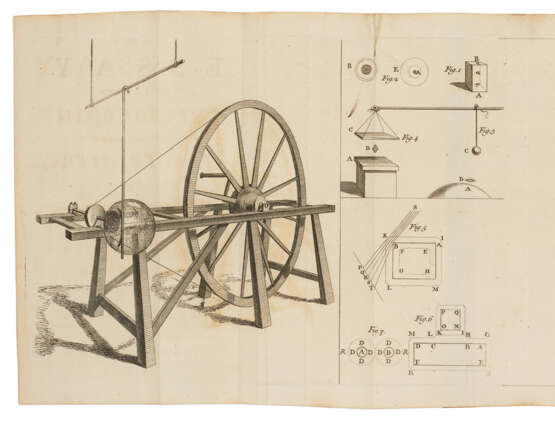Nine tracts on experiments in electricity, the Macclesfield copy
27.01.2023 10:00UTC +00:00
Classic
Startpreis
100USD $ 100
| Auctioneer | CHRISTIE'S |
|---|---|
| Veranstaltungsort | Vereinigtes Königreich, London |
| Aufgeld | see on Website% |
Archiv
Die Auktion ist abgeschlossen. Es können keine Gebote mehr abgegeben werden.

ID 887793
Los 20 | Nine tracts on experiments in electricity, the Macclesfield copy
Schätzwert
$ 4 000 – 6 000
Desaguliers, John Theophilus. A Dissertation concerning Electricity. London. W. Innys and T. Longman, 1742. * Watson, William. Experiments and Observations tending to illustrate the Nature and Properties of Electricity. In one Letter to Martin Folkes, Esq; President, and Two to the Royal Society. London. J.Ilive, for the author, 1745. * Watson, William. A Sequel to the Experiments and Observations... wherein it is presumed ... that the Source of the Electrical Power, and its Manner of acting are demonstrated. Addressed to the Royal Society. London, for C. Davis, Printer to the Royal Society, 1746. * Wilson, Benjamin. An Essay towards the Explication of the Phaenomena of Electricity, deduced from the Aether of Sir Isaac Newton, contained in Three papers which were read before the Royal Society. London: for C. Davis, Printer to the Royal Society, and M. Cooper, 1746. * Watson, William. An Account of the Experiments made ... in order to discover whether the Electrical Power would be sensible at great distances. With an Experimental Inquiry concerning the respective Velocities of Electricity and Sound ... Communicated to the Royal Society. London: for C. Davis, 1748. * Martin, Benjamin. An Essay on Electricity: Being an Enquiry into the Nature, Cause and Properties thereof, on the Principles of Sir Isaac Newton’s Theory of Vibrating Motion, Light and Fire ... Bath: printed for the Author; and Mr. Leake, et al., 1746. * Martin, Benjamin. A supplement: containing Remarks on a Rhapsody of Adventures of a Modern Knight-Errant in Philosophy. Bath: printed for the Author; and Mr. Leake, et al., 1746. * Freke, John. An essay to shew the Cause of Electricity; and why Some Things are Non-Electricable. In which is also Consider’d its Influence in the Blasts on Human Bodies, in the Blight on Trees, in the Damps in Mines; and as it may affect the Sensitive Plant ... London: W. Innys, 1746. * Neale, John. Directions for Gentlemen, who have Electrical Machines, how to proceed in making their Experiments. Illustrated with cuts. London: printed for the author, 1747.
First editions (apart from Freke’s work) of this collection of important tracts on electricity, all published over a six-year period and reflecting the experiments of members of the Royal Society into electrical phenomena. Freke is here in its expanded second edition, with appendix. The texts center around an exciting period in the history of electrical research; as Priestley says, "the end of the year 1745, and the beginning of 1746 were famous for the most surprising discovery that has yet been made in the whole business of electricity, which was the wonderful accumulation of its power in glass, called at first the Leyden phial" (Priestley, p. 82). Desaguliers, whose work appears at the start of the collection, was "the first to divide bodies into 'electricks,' or non-conductors, and 'non-electricks,' or conductors. ... His 'Dissertation ...' is said to be the second work on the subject published in the English language, the first having been Boyle’s 'Mechanical Origin and Production of Electricity'" (Mottelay, pp. 166–7). It contains brief accounts of 29 experiments, mostly using a "Tube of Glass which is rubb’d by the hand," and one of which involves a man (or any other animal) "suspended horizontally (as in a swimming posture) by two Hair Ropes." William Watson, meanwhile, pioneered the demonstration that electricity could traverse large distances over negligible periods of time. He has been called "the most distinguished name in this period of the history of electricity" (Mottelay, pp. 175–6) and was "the first to apply the terms plus and minus to electrical polarities" (Meyer, p. 20). In the first of his works contained here, he outlines his success in "firing Spirit of Wine" and other substances "by the Power of Electricity"; in the second he discusses further experiments relating to the Leyden phial. The other works in the volume provide different experimental and theoretical perspectives on mid-eighteenth-century approaches to electricity, including the controversy which ensued between Martin and Freke. Neale, meanwhile, offers accounts of 50 experiments that "such private persons as are provided of an electrical machine and a requisite apparatus" could conveniently carry out; he manufactured and sold such machines at his house in Leaden-Hall Street, as an illustrated advertisement at the end of the work attests. H. W. Meyer, A History of Electricity and Magnetism, Cambridge, Mass. 1971; P. F. Mottelay, Bibliographical History of Electricity and Magnetism, London 1922; and J. Priestley, The History and Present State of Electricity, 4th ed., London 1775.
Octavo (189 x 116 mm). Three folding engraved plates total. Contemporary mottled calf, gilt spine, red morocco lettering-piece with gilt lettering. Provenance: manuscript list of contents on front free endleaf – Library of the Earls of Macclesfield (bookplate to front pastedown and blindstamp to first title-page; Macclesfield sale, Sotheby's, 4 November 2004, lot 683).
| Herkunftsort: | Frankreich |
|---|---|
| Kategorie des Auktionshauses: | Medizin und Wissenschaft |
| Herkunftsort: | Frankreich |
|---|---|
| Kategorie des Auktionshauses: | Medizin und Wissenschaft |
| Adresse der Versteigerung |
CHRISTIE'S 8 King Street, St. James's SW1Y 6QT London Vereinigtes Königreich | |
|---|---|---|
| Vorschau |
| |
| Telefon | +44 (0)20 7839 9060 | |
| Aufgeld | see on Website | |
| Nutzungsbedingungen | Nutzungsbedingungen |


